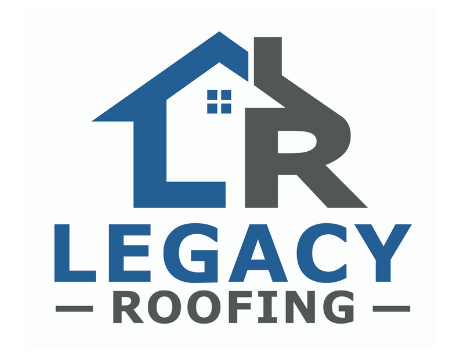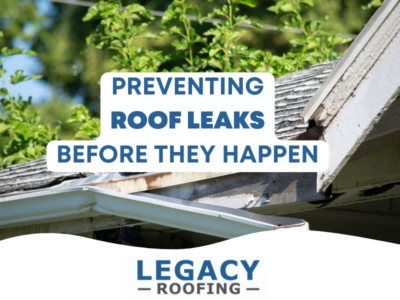Are you looking to prevent roof leaks before they happen but don’t know where to start?
Dealing with a leaking roof is never fun. A leaky roof can lead to significant damage, costly repairs, and headaches. Preventing roof leaks before they happen is crucial to maintain your home’s structural integrity and longevity. By taking proactive measures and conducting regular inspections, homeowners can safeguard their roofs from leaks.
This article will explore six essential strategies to prevent roof leaks before they become a problem.
How to Prevent Roof Leaks in 6 Simple Steps!
Regular roof maintenance can prevent a roof leak. A roof repair is vital if you suspect a roof leak to prevent further damage. So when it comes to preventing roof leaks, we offer six simple solutions to prevent you from ever messing with a leaking roof.
1. Schedule Regular Roof Inspections
For starters, if you want to prevent roof leaks, start by regularly inspecting your roof. You can do this by looking for missing shingles, out-of-place items on your roof and even using binoculars to view your roof.
Ideally, a professional roofing contractor should inspect your roof at least once a year, preferably in the spring or fall when weather conditions are mild.
During the inspection, the roofer will assess the roof’s condition, look for signs of wear and tear, and identify potential weak points. Addressing minor issues early on can prevent them from escalating into major leaks later. A roof leak repair is always cheaper compared to a total roof replacement.
2. Keep Your Gutters and Downspouts Clean

Clogged gutters and downspouts are a leading cause of roof leaks. Yes, you read that correctly. Roof leaking is often attributed to gutters that need some TLC.
When gutters become blocked with debris such as leaves, twigs, and dirt, water cannot flow freely, pooling on the roof’s surface. This standing water can seep into the roofing materials, causing leaks and water damage inside the home.
To prevent gutter clogs, regularly clean your gutters and downspouts, particularly in the spring and fall, when they are most likely to accumulate debris. Consider installing gutter guards to reduce the cleaning frequency and keep your gutters free from blockages. Self-cleaning gutter guards are the ideal solution to never having to clean your gutters regularly again.
3. Trim those Overhanging Branches
Overhanging branches from nearby trees may look picturesque, but they can significantly threaten your roof’s integrity.
During storms or heavy winds, these branches can rub against the roof’s surface, causing abrasion and potential damage to shingles or other roofing materials. Additionally, falling branches or limbs can puncture the roof, leading to leaks and extensive water damage.
Trim back any overhanging branches to a safe distance from your roof, and consider consulting with an arborist for guidance on maintaining tree growth away from your home.
New Roof Info ↗
See and learn more about the Legacy Roofing roof replacement process!
Roof Pricing ↗
Learn about the pricing model and cost guide for a new roof!
Roofing FAQ ↗
Get to know more about the most frequently asked roofing questions!
4. Upkeep Your Roof’s Flashing
Your roof flashing is vital in preventing leaks around roof openings, such as chimneys, vents, and skylights.
Flashing is a metal or other weather-resistant material installed to seal gaps and direct water away from vulnerable areas. Over time, flashing can become corrupted or damaged, compromising its effectiveness. As part of your regular roof inspections, check the condition of the roof flashing and replace it if necessary.
Properly installed and maintained flashing will provide additional protection against potential roof leaks. After missing shingles and clogged gutters, flashing is often a common cause of faulty roof materials that cause a leaky roof!
5. Address Your Roofing Materials Age:

The choice of roofing materials and the age of your roof can influence its susceptibility to leaks. Some roofing materials, such as asphalt shingles, are more prone to damage from extreme weather conditions, while others, like metal or slate, offer superior durability and longevity. Invest in high-quality roofing materials appropriate for your climate when replacing your roof or building a new home.
Furthermore, be aware of your roof’s age and plan for regular maintenance or replacement as it nears the end of its lifespan. Older roofs are more susceptible to leaks and may require more frequent inspections and repairs.
➡️See Shingle Color Trends here!
6. Act Quickly on Warning Signs
Lastly, acting promptly on warning signs can prevent minor issues from escalating into significant roof leaks. When roof repairs are left unresolved, it might lead to a more expensive roof replacement.
Some common warning signs of potential roof problems include:
- Water stains on ceilings or walls
- Peeling or bubbling paint on ceilings
- Damaged or missing shingles
- Damp or musty odors in the attic
- Sagging roof areas
- Excessive granule loss in gutters
- Shingle curling or blistering
If you notice any of these signs, don’t delay in addressing them. Contact a professional roofer to assess the situation and make necessary repairs. Timely intervention can save you from expensive and extensive damage in the future.
The Final Word –
If you happen to live in or around Boise, Idaho, you know what the weather is like… hot summers and extreme winters. While these are ideal for enjoying the seasons, that is not always the case for the longevity of your roof.
Remember, to fix a leaking roof; you will most likely need to cause a professional roofing company. From ladder safety to roofing knowledge, roof repair is rarely a DIY job. If you fail to take a roof leak seriously, you could be looking at more damage.
On the other hand, if the damage is significant enough, you might have to contact your insurance to submit a claim for a roof replacement.
Legacy Roofing Idaho – Service Areas
Frequently Asked Questions for Leaking Roofs:
1. How often should I schedule roof inspections to prevent leaks?
It is recommended to schedule professional roof inspections at least once a year. However, if your area experiences extreme weather conditions, such as heavy storms or hurricanes, consider having your roof inspected more frequently, ideally before and after the severe weather season.
You can also observe your roof to monitor missing shingles, out-of-place items, etc.
Can I conduct roof inspections myself, or should I hire a professional?
While it’s possible to perform essential visual inspections from the ground, hiring a professional roofing contractor for thorough inspections is best.
Roofers have the expertise and knowledge to identify potential problem areas that may go unnoticed by an untrained eye. Professional inspections are vital for the early detection and effective prevention of roof leaks.
Feel free to contact Legacy Roofing if you live around Boise, Nampa, Meridian, or the surrounding areas.
How do I know if my gutters and downspouts need cleaning?
Clogged gutters and downspouts can cause water backup and roof leaks. You should inspect them regularly for signs of blockages, such as water overflowing from the gutters during rain or visible debris accumulation.
Cleaning gutters and downspouts at least twice a year, particularly in the spring and fall, will help prevent potential leaks. You can also consider hiring a professional gutter company to install gutter guards.
Are there any DIY solutions for maintaining roof flashing?
DIY maintenance for roof flashing is possible in some cases, but we DO NOT recommend it. A roof leak is nothing to play around with and fixing a roof leak from flashing requires quite a bit of knowledge.
For minor issues, such as loose flashing, you can use roofing cement or silicone sealant to secure it back in place. However, for more significant flashing problems or extensive roof leaks, it is advisable to hire a professional roofer to ensure proper repairs and prevent further damage.
Can the age of my roof make it more vulnerable to roof leaks?
Yes, the age of your roof can play a role in its vulnerability to leaks. As roofs age, they are more likely to experience wear and tear, which can lead to compromised roofing materials and potential leaks.
Regular inspections become even more critical as your roof nears the end of its expected lifespan, and planning for timely replacement can help prevent leaks and water damage. This is also why regular roof leak repairs are vital. Leaks that go unrepaired can lead to bigger issues.
What should I do if I notice water stains on my ceilings?
Water stains on ceilings are often indicative of a roof leak. Whether the pipe collar on your roof is leaking or it is caused by a missing shingle, you will want to call an expert for a roof repair right away.
If you notice such stains, addressing the issue promptly is essential. First, identify the source of the leak and try to contain the water to prevent further damage. Then, contact a professional roofer to inspect and repair the roof to prevent the leak from worsening.


 Pros and Cons of Asphalt Shingles: The Good, the Bad, and the Asphalt:
Pros and Cons of Asphalt Shingles: The Good, the Bad, and the Asphalt: